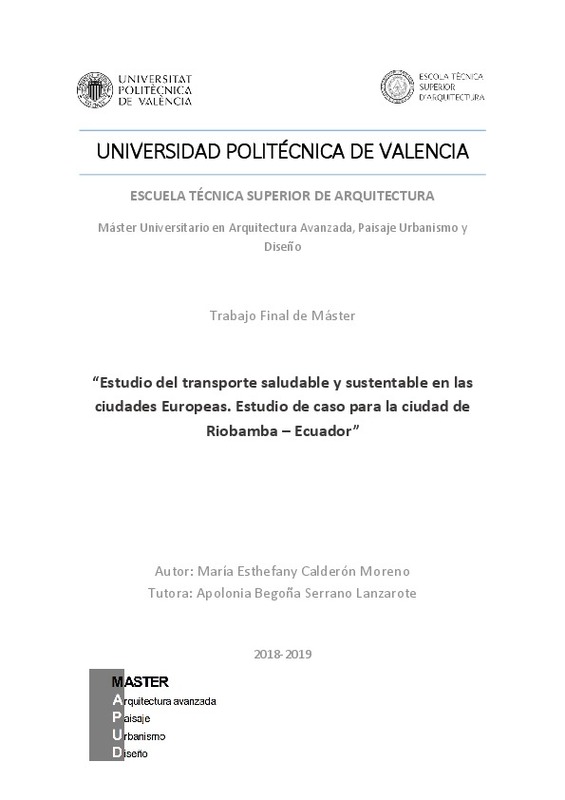JavaScript is disabled for your browser. Some features of this site may not work without it.
Buscar en RiuNet
Listar
Mi cuenta
Estadísticas
Ayuda RiuNet
Admin. UPV
Estudio del transporte saludable y sustentable en las ciudades europeas: estudio de caso para la ciudad de Riobamba, Ecuador
Mostrar el registro sencillo del ítem
Ficheros en el ítem
| dc.contributor.advisor | Serrano Lanzarote, Apolonia Begoña
|
es_ES |
| dc.contributor.author | Calderón Moreno, María Esthefany
|
es_ES |
| dc.coverage.spatial | east=-78.6449786; north=-1.6547648; name=Avenida Antonio Jose de Sucre, Riobamba, Equador | es_ES |
| dc.date.accessioned | 2019-09-25T12:55:48Z | |
| dc.date.available | 2019-09-25T12:55:48Z | |
| dc.date.created | 2019-06-17 | |
| dc.date.issued | 2019-09-25 | es_ES |
| dc.identifier.uri | http://hdl.handle.net/10251/126355 | |
| dc.description.abstract | [ES] Desplazarse de un lugar a otro debe ser una actividad accesible para todos los habitantes, por esta razón la planificación de los medios de transporte y sus usos deben ir a la par con la planificación urbana. La movilidad urbana sostenible relaciona la accesibilidad con la facilidad de desplazamiento de los habitantes y la infraestructura que apoya a la movilidad y desplazamiento para que esté al alcance de todos. El presente trabajo pretende realizar un análisis y recopilación de las principales ciudades europeas que se han alineado a la Nueva Agenda Urbana 2030 y que han implementado técnicas y metodologías para la movilidad urbana sostenible. El uso de alternativas de otros medios de desplazamiento para la movilidad permite que la sociedad utilice medios de transporte diferentes a los vehículos motorizados, habitantes que de alguna manera se han sentido excluidos en el tema de movilidad. Se busca ejercer un derecho a la movilidad, un derecho en el que las personas puedan desplazarse de un lugar a otro. El alto crecimiento del parque automotriz, falta de estacionamiento en la ciudad, la congestión vehicular, embotellamientos, la contaminación del medio ambiente en la ciudad de Riobamba Ecuador, la falta de señalética para los ciclistas, ha impulsado el siguiente trabajo en el cual se toma a la ciudad como caso de estudio para realizar un análisis de las políticas de movilidad aplicadas en la misma. Se considerará a la Nueva Agenda Urbana 2030, los objetivos de desarrollo sostenible, ciudades verdes de Europa para tomar criterios que sean aplicables de acuerdo a las necesidades y requerimientos de la ciudad de Riobamba, y así diseñar una red básica de carril bici que permita el desplazamiento de los habitantes como un medio de transporte sostenible, sustentable y accesible. | es_ES |
| dc.description.abstract | [EN] Moving from one place to another should be an activity accessible to all inhabitants, for this reason the planning of means of transport and its uses should go hand in hand with urban planning. Sustainable urban mobility relates accessibility to the ease of displacement of the inhabitants and the infrastructure that supports mobility and displacement so that it is accessible to all. The present work intends to carry out an analysis and compilation of the main European cities that have aligned themselves with the New Urban Agenda 2030 and that have implemented techniques and methodologies for sustainable urban mobility. The use of alternative means of travel for mobility allows society to use means of transport different from motorized vehicles, inhabitants that have somehow felt excluded in the issue of mobility. It seeks to exercise a right to mobility, a right in which people can move from one place to another. The high growth of the automotive park, lack of parking in the city, traffic congestion, traffic jams, pollution of the environment in the city of Riobamba - Ecuador, lack of signage for cyclists, has prompted the following work in which takes the city as a case study to perform an analysis of the mobility policies applied in it. The New Urban Agenda 2030 will be considered, the sustainable development objectives, green cities of Europe to take criteria that are applicable according to the needs and requirements of the city of Riobamba, and thus design a basic network of bike lanes that allows the displacement of the inhabitants as a sustainable, accessible and sustainable means of transport. | es_ES |
| dc.format.extent | 151 | es_ES |
| dc.language | Español | es_ES |
| dc.publisher | Universitat Politècnica de València | es_ES |
| dc.rights | Reserva de todos los derechos | es_ES |
| dc.subject | Movilidad | es_ES |
| dc.subject | Sostenibilidad | es_ES |
| dc.subject | Buenas prácticas | es_ES |
| dc.subject | Carriles bici | es_ES |
| dc.subject | Ciudades | es_ES |
| dc.subject | Nueva agenda | es_ES |
| dc.subject | Agenda 2030 | es_ES |
| dc.subject | Mobility | es_ES |
| dc.subject | Sustainability | es_ES |
| dc.subject | Good practices | es_ES |
| dc.subject | Cycle lanes | es_ES |
| dc.subject | Cities | es_ES |
| dc.subject | New agenda | es_ES |
| dc.subject.classification | MECANICA DE LOS MEDIOS CONTINUOS Y TEORIA DE ESTRUCTURAS | es_ES |
| dc.subject.other | Máster Universitario en Arquitectura Avanzada, Paisaje, Urbanismo y Diseño-Màster Universitari en Arquitectura Avançada, Paisatge, Urbanisme i Disseny | es_ES |
| dc.title | Estudio del transporte saludable y sustentable en las ciudades europeas: estudio de caso para la ciudad de Riobamba, Ecuador | es_ES |
| dc.type | Tesis de máster | es_ES |
| dc.rights.accessRights | Abierto | es_ES |
| dc.description.bibliographicCitation | Calderón Moreno, ME. (2019). Estudio del transporte saludable y sustentable en las ciudades europeas: estudio de caso para la ciudad de Riobamba, Ecuador. http://hdl.handle.net/10251/126355 | es_ES |
| dc.description.accrualMethod | TFGM | es_ES |
| dc.relation.pasarela | TFGM\97661 | es_ES |
Este ítem aparece en la(s) siguiente(s) colección(ones)
-
ETSA - Trabajos académicos [4687]
Escuela Técnica Superior de Arquitectura






